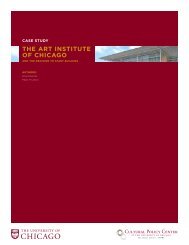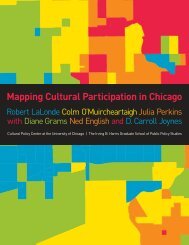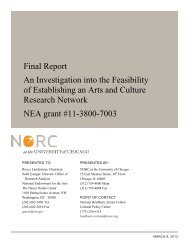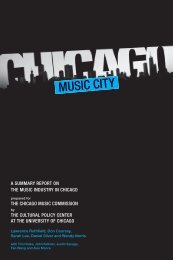Incumbents, innovation, and competence - Cultural Policy Center ...
Incumbents, innovation, and competence - Cultural Policy Center ...
Incumbents, innovation, and competence - Cultural Policy Center ...
You also want an ePaper? Increase the reach of your titles
YUMPU automatically turns print PDFs into web optimized ePapers that Google loves.
Our model also tests the alternative that dominant incumbents relied on multiple takes<br />
because of extensive resources (e.g., recording until perfection is achieved). If so, one<br />
would expect that jazz orchestras would be less likely to have a first-take recording than<br />
other jazz groups (contrary to Hypothesis 2).<br />
4. Data <strong>and</strong> methods<br />
4.1. Data sources<br />
D.J. Phillips, D.A. Owens / Poetics 32 (2004) 281–295 287<br />
Our data on the recording industry come from the Directory of American Disc Record<br />
Br<strong>and</strong>s <strong>and</strong> Manufacturers, 1891–1943 (Sutton, 1994). It includes every commercial <strong>and</strong><br />
semi-private disc record br<strong>and</strong> manufacturer. Moreover, it provides descriptions of each<br />
firm that allow us to follow any changes of corporate ownership. This source yielded 73<br />
record companies over 405 firm-years, with only one African-American-owned company—Black<br />
Swan (1921–1924). Our data on recordings are drawn from the twovolume<br />
discography, Jazz Recordings, 1897 to 1943 (Rust, 1969). It lists the recording<br />
date, song title, recording label, catalogue number, group name (<strong>and</strong> pseudonym), <strong>and</strong><br />
city for each recording, along with a listing of musicians <strong>and</strong> their corresponding<br />
instruments.<br />
We bound our sample in two ways. First, we include only those recordings done in the<br />
Midwest (e.g., Chicago, Minneapolis, St. Louis, Cincinnati, Kansas City) <strong>and</strong> exclude<br />
recordings from cities or regions outside of the Midwest (e.g., New York City). There are<br />
two potential drawbacks to this: we are neglecting important recordings made elsewhere<br />
<strong>and</strong> are not capturing recordings by Midwest musicians made in non-Midwest cities.<br />
Regarding the first drawback, jazz historians <strong>and</strong> musicologists note that the Midwest was<br />
the region from which recorded jazz emerged (e.g., Kenney, 1993). Also, jazz improvisation—‘‘hot’’<br />
jazz—has been singly identified as initiated by Midwest musicians before<br />
diffusing to other regions of the country (Kenney, 1993; Peretti, 1992). Regarding the<br />
second drawback, our examination of Rust’s (1969) discography suggests that musicians<br />
who resided in the Midwest typically made recordings in Midwest studios. On average,<br />
over 91% of each group’s recordings took place in the Midwest. Moreover, 85% of the<br />
groups never recorded outside of the Midwest. Finally, there were very few occurrences of<br />
musicians who actively recorded across different regions in the 1920s.<br />
The second way in which we bound our data is by ending our observation period at 1929.<br />
The primary justification for doing so is the onset of the Great Depression, which nearly<br />
decimated the record industry. Indeed, Victor <strong>and</strong> Columbia survived only by merging with<br />
radio interests to form what would be known as RCA <strong>and</strong> CBS, respectively (Leonard,<br />
1962; Sutton, 1994). The secondary justification is that the late 1920s were characterized<br />
by a migration of jazz music from the Chicago <strong>and</strong> the Midwest—its commercial<br />
birthplace—to New York <strong>and</strong> the Northeast. By the 1930s New York became the new<br />
center of jazz music with prominent musicians moving to Harlem <strong>and</strong> other areas of the<br />
New York region. Louis Armstrong, for instance, traveled from the Midwest to record in<br />
New York for the first time in 1929 (Rust, 1969). After bounding the sample, our recording<br />
data encompass 2656 recordings by 497 groups.









